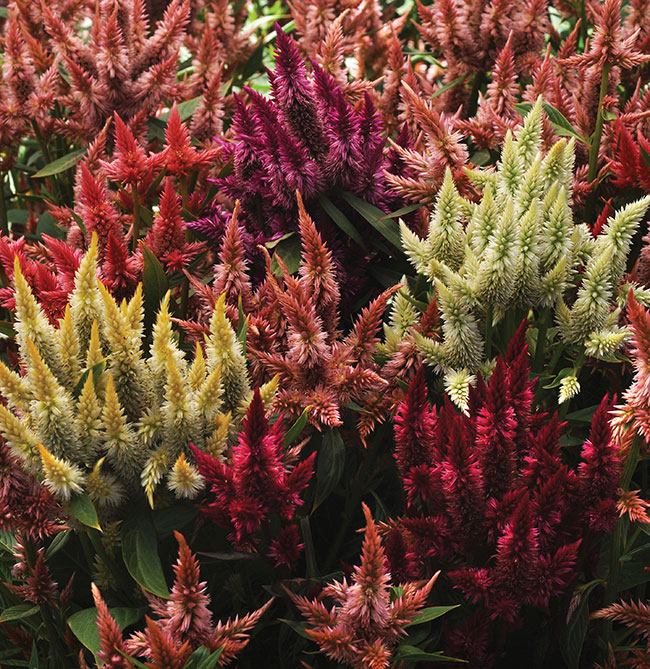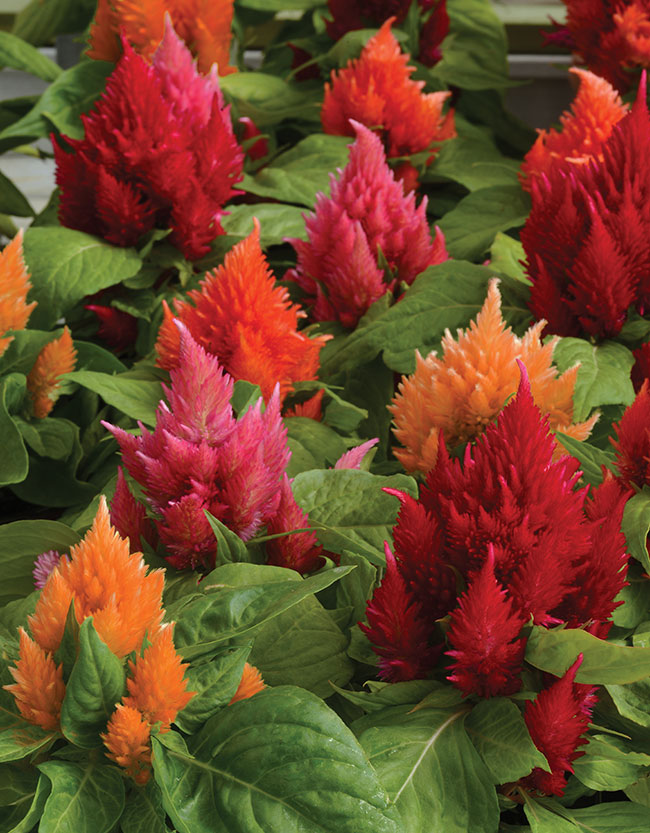
Year of the Celosia
Late last year, National Garden Bureau (NGB) announced six new “Year of the” crops for the coming year. One crop from each category is selected by the NGB board of directors to be highlighted and promoted throughout the industry; an annual, perennial, bulb crop, edible, shrub and houseplant are selected specifically for the North American market. These crops are chosen because they are easy to grow, popular, and have good adaptability, genetic diversity, and versatility.
National Garden Bureau generates a lot of publicity throughout the year from this program, which is a great incentive for breeders, brokers, seed companies, growers and garden centers to consider promoting these plants when planning their marketing campaigns for the new year. The NGB website also provides great marketing tools for use like fact sheets, posters and presentations for each of the non-branded, non-specific varieties to help encourage consumers to take interest in these plants and use them for their gardening activities.
For the annuals category, celosia was selected for 2023. The flowers come in many colors, and different varieties have appealing shapes that pop in any garden. To learn more about this crop, I reached out to some experts in the industry to see what they had to say about celosia: Scott Mozingo, regional sales manager at Griffin Greenhouse Supplies; Denise Mullins, director of product innovation at Smith Gardens; and Tim Kaewrianthong, global product manager at PanAmerican Seed.
GPN: Are you familiar with the National Garden Bureau’s “Year of” program? Do you take advantage of and promote the selected crops when they pertain to your business?
Scott Mozingo: I’m a board member for NGB, and I was excited to see celosia chosen for the “Year of the” program. Griffin does use NGB promotional materials in its marketing to our grower customers. This helps drive awareness to growers that customers will be looking for these items NGB is promoting. In addition to the unique logo style for “Year of” that people will recognize, NGB does a great job with written materials to help talk about the products with fun facts and longer form blog posts.
Denise Mullins: Yes, I am aware of NGB and we do promote the selected items where we can.
Tim Kaewrianthong: PanAmerican Seed has been a big supporter of the National Garden Bureau, and we are always pleased when our plant classes align with a “Year of” promotion. We welcome any chance to build excitement with the consumer audience, especially with plant classes that are less well-known in the general gardening world.
GPN: 2023 has been named the “Year of the Celosia.” In your opinion, why do you think this crop was selected for the upcoming year?
Scott: I think celosia is an old crop that’s being discovered again by gardeners as breeders have introduced new, standout varieties and series. It’s a genus with so many unique flower forms and colors that even experienced gardeners are finding new things to love about it. Additionally, there’s a real rise in small farm cut flower growers, and you see a lot of beautiful Instagram bouquets that feature celosia, and home gardeners are inspired to try them at home.
Denise: There has been a lot of breeding in celosia over the past few years and there is a lot to choose from on the market. The category needed some attention.
Tim: After almost three years of the COVID-19 pandemic and the world feeling locked down, people are looking for an outdoor life. Celosia is one representative of a crop that can draw you outside, with its bright and vivid colors, plus easy landscaping performance. Celosia is suitable for refreshing the garden, enjoying outdoor spaces and a breath of fresh air after a long solitary period. It meets plenty of sensory opportunities through touch as well due to its plumed and spiky textures.
GPN: What has been your role and experience in the development, marketing and/or sale of celosia?
Scott: Griffin offers seeds and plants of existing breeding for our customers, but we’re not a breeding company. We feature products and our sales force makes recommendations to growers for programs.
Denise: My role at Smith Gardens is in product innovation. Celosia is one of those annuals that has amazing floral color and texture. There are so many great varieties that you can work into every program (i.e., pot size) and/or every part of your landscape, whether in-ground or in a container on your patio.
Tim: I am a PanAmerican Seed product development manager who works closely with breeding and sales teams as they develop new types of celosia, and build marketing plans around them to serve the needs of consumers.
‘Celway’ mixture
‘First Flame Scarlet’
'Ice Cream’ mix
GPN: What changes and innovations have you seen in recent years in the celosia category?
Denise: In the past 20 years, I’ve seen celosia going from your basic plumosa or spicata type to amazing hybrids with more unique flower structures to extremely vigorous plants with large plumes. With cut flower gardening starting to trend heavier, these newer genetics, I believe, will only become more popular.
Tim: We’re seeing a move toward developing bright and vivid colors in celosia, as well as building in tolerance to the weather, along with other plant durabilities.
GPN: How can growers capitalize on celosia?
Scott: People who are new to gardening aren’t as familiar with this genus, as it was relegated to packs for so long. If you haven’t taken a look at the new standalone varieties and series, you should. Also, take advantage of the marketing materials available from the breeders and NBG to drive some excitement through your emails, social media and other advertising.
Denise: There are varieties on the market that can be tricky to grow, meaning they are more day-length sensitive than others. However, there are so many varieties to choose from that growers can choose the ones that fit their environment and/or their market.
Tim: Celosia is so versatile! It can be used as a potted plant for decorating indoor spaces, in a patio container for a small-space or limited outdoor area, or it can be used in a landscape design or a larger bedding space. There are also multiple sizes, from compact to tall, and even cut-flower sizes to meet many needs. Many varieties can also work in high-density production so you can bench-run a large quantity.
GPN: What are some new/unique/special recent celosia introductions? What are their characteristics?
Scott: The introduction of ‘Dragon’s Breath’ from Sakata a few years back really opened people’s eyes to how celosia could be a unique standalone crop for retail, and sales exploded. It’s a great name, but it’s a gorgeous, tall, flowering plant. When retailers offer this in large gallon pots to show the instant wow-factor, gardeners can’t help but try it. PanAmerican Seed introduced ‘Dracula’ with that gorgeous “brain” in dark burgundy and that really caught attention as well. Again, if you grow this one larger, so customers can see the big flower and don’t have to wait — it’s a great impulse buy.
Denise: The first two that pop to mind is celosia Flamma series from Sakata (introduced in 2022) with extremely bright plumes that do not fade or decline throughout the season. Also, Sakata’s celosia ‘Dragon’s Breath’, which is not that new (introduced in 2015); however, there is nothing else like it on the market. Its massive flower size and vigor make it an amazing focal point on a patio! The Twisted series from Ball FloraPlant is a hybrid C. cristata variety that has attractive and unique flowers that are a standout.
Tim: Plant durability is a goal for our breeders — plants that stand up to temperature, weather, lack of moisture, pests or even neglect. We’d like to help gardeners be intrigued by celosia’s unique flower forms and fun colors, but also be confident in their purchase to provide enjoyment throughout the gardening season.
GPN: Is there anything in the pipeline in the celosia category that you can share?
Tim: Have you explored our foliage celosia Sol collection yet? These are varieties prized for their leafy foliage in bronzy reds and greens; their small flowers are just an added bonus. These have a fast production time and no downy mildew issues. They take full sun and are perfect foliage complements in a mixed container or as a border accent plant.
GPN: What makes celosia especially appealing to consumers?
Scott: Celosia is a big genus with so much variety — you can try large plume types, cut flower types, flowers that look like brains — and they’re offered in so many colors, how could you not find one to love?
Denise: I believe it’s the complete sensory satisfaction that celosia gives. The bright colors are magnetic, and then you can’t help but touch this plant. It’s great for cut flower gardening, children’s gardens, centerpieces in planters, accents in the garden, and you can eat this plant. Even though we do not here in the U.S., other parts of the world will use the foliage as a type of “spinach” (aka Lagos Spinach) or greens for cooking.
Tim: Celosia have bright and vivid color with a flower form that makes people stop in their tracks to touch or comment on its unique texture. It is a versatile class that is relatively easy to care for — especially for the new gardener who is uncomfortable with the idea of ongoing maintenance to increase flower production. The simplicity of celosia’s appeal can’t be overstated.
For an enhanced reading experience, view this article in our digital edition by clicking here.












 Video Library
Video Library 


















